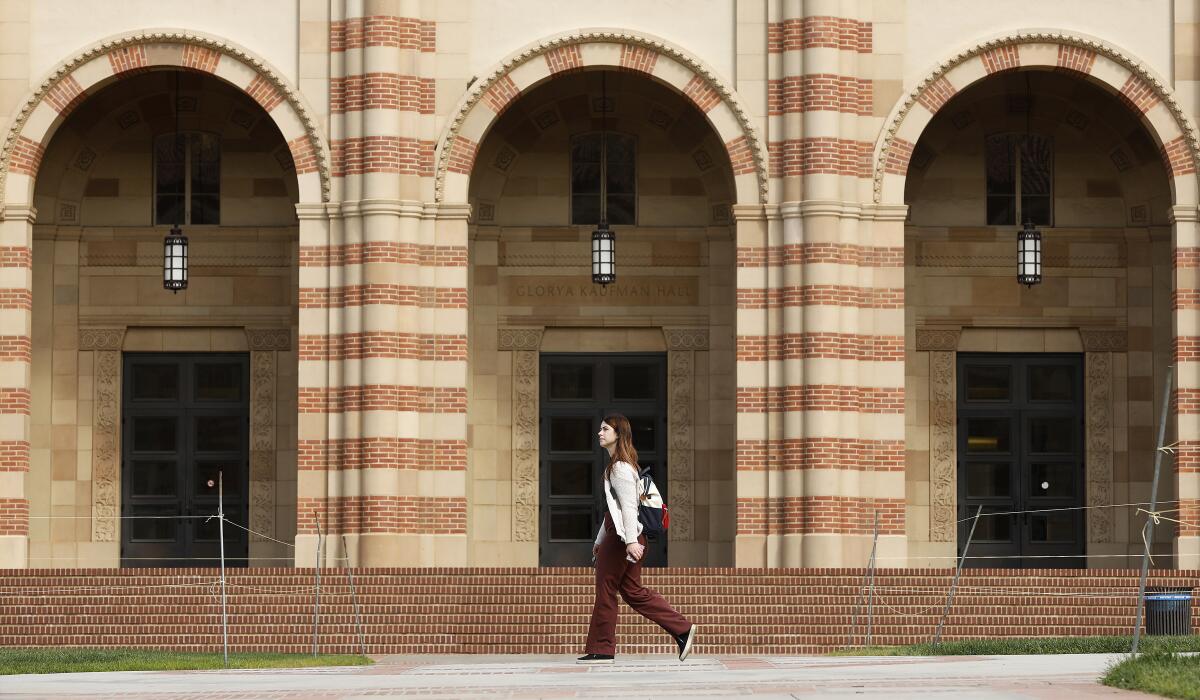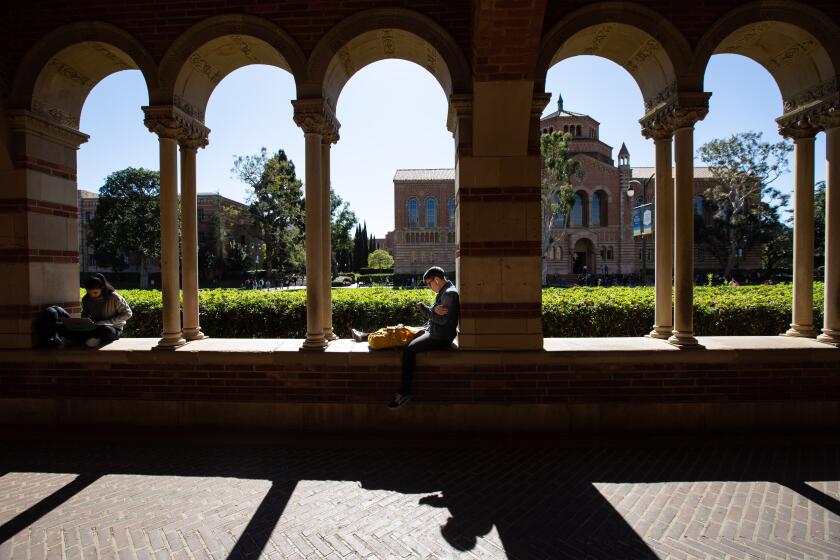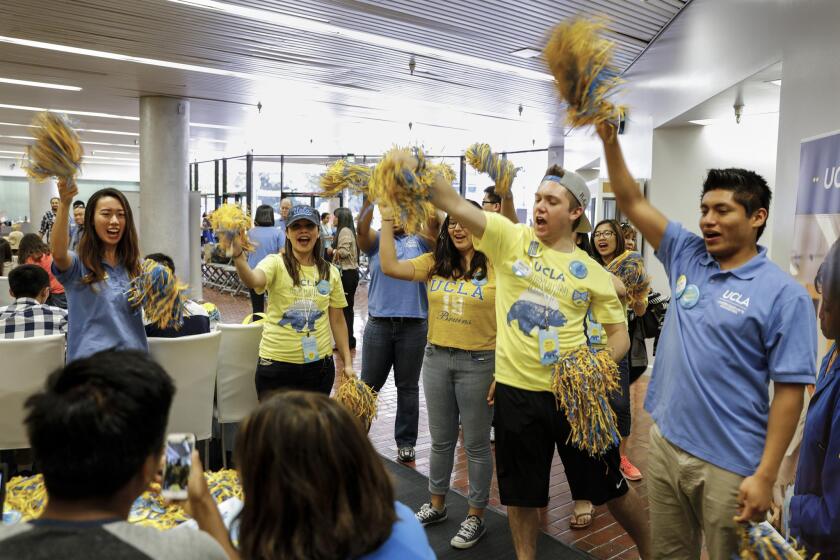UC could grow by 33,000 California students, equivalent of new campus, to meet surging demand

- Share via
The University of California, facing record surges in applications, could increase seats for California students by as many as 33,000 by 2030 — the equivalent of building a new campus.
At least half the growth would come at the UC system’s most popular campuses — UCLA, UC Berkeley and UC San Diego — in part by reducing the number of out-of-state and international students and giving those seats to Californians.
UC does not plan to build a new campus because of time and expense. But the system’s nine undergraduate campuses are crafting plans to accommodate increased enrollment with more online courses, summer offerings, off-campus programs, potential satellite locations and additional support to help students graduate more quickly, which would free up seats.
The ambitious goals were presented at the UC Board of Regents meeting in San Francisco this week and represent a 50% increase from UC’s previously announced plan to expand enrollment by more than 20,000 by 2030. The lower target has secured state multiyear funding commitments, but UC President Michael V. Drake noted that the higher “aspirational” goal of 33,000 will require additional resources for more faculty, classrooms, teaching labs, student housing and support services.
“Our goal all along has been to grow in a way that serves the state of California and meets its future education and workforce needs, while being responsive to each of the communities we call home,” Drake told regents this week.
At least one state legislator said he’s all in on the higher target: Assemblyman Kevin McCarty (D-Sacramento), chair of an Assembly subcommittee on education finance who has long pushed UC to increase seats for California students.
One way to do that is to replace some out-of-state and international students with California residents, a process UCLA, UC Berkeley and UC San Diego started this year with increased state support to cover the loss of higher tuition that nonresidents pay. McCarty said he and his legislative colleagues would be “very open” to funding a continued phasedown of nonresident students to as little as 10% of the undergraduate enrollment — the systemwide average is now about 18%, with UCLA, UC Berkeley and UC San Diego at about 24%.
“This is music to my ears,” McCarty said of UC’s enrollment targets. “This is exactly what we’ve been pushing for in the last five, 10 years — to increase access for highly qualified California students. This is a top, top priority for the Legislature.”
The University of California drew a record number of first-year applications for fall 2022, with gains in all underrepresented groups; transfer applications fell.
The expanded enrollment plan comes as applications to UC have hit record highs. The system’s nine undergraduate campuses drew nearly 211,000 first-year applications for fall 2022, a 3.5% increase over last year, as the elimination of standardized test requirements and greater online outreach paid dividends in drawing the largest and most diverse applicant pool ever.
UC has detailed its enrollment plan in an 88-page report, which said the system’s growth should be “intentionally” planned to increase graduation rates, close equity gaps, reflect the state’s diversity, support underserved areas such as the Inland Empire and San Joaquin Valley, and meet state workforce needs in healthcare, education, science and technology fields.
Each campus has different capacities and strategies to grow.
UCLA and UC Berkeley, for instance, are at physical space limits and must look to increase students without adding more people on campus. In a presentation to regents, UCLA Chancellor Gene Block said the school is exploring off-campus programs in Los Angeles and satellite locations that could accommodate 600 to 1,000 more students. One possible satellite site is in San Pedro, where UCLA already is working with AltaSea, a public-private venture aimed at ocean science.
UC Berkeley also is considering a satellite program at Moffett Field, owned by NASA, that would focus on aerospace science and engineering. The campus has agreed to limit growth of undergraduates to 1% annually under its long-range development plan after the city and neighbors voiced opposition to more students in the community.
UC Davis is building Aggie Square, an “innovation hub” on its Sacramento campus that will include science and technology buildings and student housing. The campus estimates a few hundred undergraduates can spend a quarter there.
Campuses are also hoping to absorb more students in summer courses, which saw a significant increase in enrollment across the UC system in 2020 and 2021 — especially at UC Santa Cruz.
At UCLA, Block said a more robust summer quarter could potentially enroll an additional 2,000 students. And another 300 seats could open if students graduate more quickly, he said, adding that the campus has increased support services — including the Black Bruins Resource Center, launched last year, and expanded programs for Latinos, Native Americans and Pacific Islanders.
“I’m really confident that UCLA, as crowded as it is, can grow,” Block said.
A space crunch is projected to intensify in coming years just as the need for highly skilled workers in California grows.
UC Merced and UC Riverside are estimating they can jointly provide about one-third of the proposed growth.
UC Merced Chancellor Juan Sánchez Muñoz told regents his Central Valley campus, which has completed a $1.2-billion expansion project of new student housing, classrooms, research labs and wellness facilities, can add 2,000 more students. A new UC Merced medical education program is set to open next year, which will have the capacity to train 200 graduate students to provide healthcare to the underserved region.
UC Riverside also has the land to grow and aims to increase its current enrollment of 28,000 to about 35,000 by 2035 under its long-range development plan. But the Inland Empire campus is short of faculty, staff and instructional space to serve its current students and would need a significant funding boost to serve more, university leaders say.
The systemwide capacity plan also envisions increasing online courses.
Before the pandemic, relatively few UC students took an online course — only 6% in fall 2019 compared with 39% at California State University, according to the report. The emergency remote courses hastily put together at the pandemic’s onset were widely panned; 60% of students who previously took a course specifically designed for online consumption said in a 2020 survey that the remote offerings were worse. But as faculty improved the quality of their online courses, 57% surveyed by the Academic Senate in spring 2021 said their interest in online teaching had increased or remained high. Some campuses are expanding those offerings, notably UC Irvine.
About one-quarter to one-third of the proposed increases in California seats would go to graduate students, who are needed to expand UC’s research capacity, teach undergraduate classes, fill a pipeline for future professors and meet the state’s workforce needs. UC lags behind other top research institutions in its share of graduate students among total enrollment, the capacity report noted.
But the enrollment growth won’t come cheap. To expand access for the proposed target of 23,000 more students, UC would seek around $324 million in state funding. That amount is consistent with the compact forged between Gov. Gavin Newsom and the university system for a multiyear commitment for a 5% annual funding increase in exchange for agreements that in part called for increasing enrollment and closing equity gaps.
To grow by the larger target of 33,000 students, UC says it would need an additional $114 million in state support for enrollment growth.
Billions more would be needed to build, repair and maintain facilities.
But Drake and the system’s 10 chancellors said they were committed to grow to “best serve the interests of California.”
“The University has a responsibility to train the next generation of doctors and nurses, judges and lawyers, business leaders, elected officials, researchers, and faculty — ones that reflect California,” they wrote in a letter accompanying the report. “We recognize the demand for a UC education is great.”
More to Read
Sign up for Essential California
The most important California stories and recommendations in your inbox every morning.
You may occasionally receive promotional content from the Los Angeles Times.













